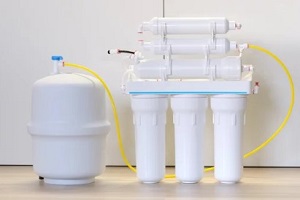 Reverse osmosis systems are a popular form of water filtration used throughout the United States to provide households and workplaces with a steady source of safe, clean and good-tasting drinking water. However, because the technology can be difficult to understand, there are many myths about reverse osmosis floating around.
Reverse osmosis systems are a popular form of water filtration used throughout the United States to provide households and workplaces with a steady source of safe, clean and good-tasting drinking water. However, because the technology can be difficult to understand, there are many myths about reverse osmosis floating around.
Whether they represent a simple misunderstanding of the way these systems function or they are a deliberate misrepresentation on the part of those selling competing water filtration products, it is important to understand how these systems work so you can separate fact from fiction and make an informed decision about the best way to filter your drinking water.
Understanding The Process Of Reverse Osmosis
In simple terms, reverse osmosis is a method for filtering water to reduce its contaminants. Unlike other methods of water filtration, it does not rely on thermal energy to work. Instead, it uses a very high amount of pressure to achieve optimal filtration.
The system places water under high pressure and then runs it through a semi-permeable membrane that is full of tiny pores that stop contaminants from getting through. After these contaminants have been filtered out, excess water is used to wash them away.
Then, the filtered clean water is placed into a storage tank and held there until the faucet attached to it is opened. Most systems will continue to filter water until the tank becomes full, at which point it will turn off until the water in the tank is used and start operating again once the tank needs to be refilled.
There are several different types of reverse osmosis systems on the market, but most of them have at least three stages that are focused on different types of contaminants. Most of them use a pre-filter that takes out sediments like dirt, dust and rust, followed by a reverse osmosis membrane that does the bulk of the filtering.
A carbon filter reduces chlorine, volatile organic compounds (VOCs) and other types of contaminants that can make water smell or taste unpleasant. Then, a carbon polishing post filter may be used to remove unwanted odors and improve the water’s flavor. It also serves as a final check against any impurities. In some systems, a remineralizing filter that can raise the water’s alkalinity may also be used as a final step.
Reverse osmosis systems use a storage tank to hold the water they have filtered to ensure there is plenty of water available when people need it. Because these systems tend to produce water rather slowly, they do not function on demand. Instead, the tank ensures there is sufficient water available when needed.
Debunking 9 Common Myths About Reverse Osmosis Water Systems
Here is a look at nine common myths about reverse osmosis water systems that simply don’t hold water.
Myth #1: Reverse Osmosis Systems Make Your Water Unhealthier By Removing Beneficial Minerals From It
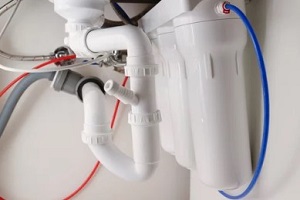 Although reverse osmosis systems do remove many of the minerals from drinking water, this does not mean that the water is not healthy to drink. First, it is important to understand that many of the minerals in water are not essential for our health; human beings get most of their minerals from the food they eat.
Although reverse osmosis systems do remove many of the minerals from drinking water, this does not mean that the water is not healthy to drink. First, it is important to understand that many of the minerals in water are not essential for our health; human beings get most of their minerals from the food they eat.
A balanced diet will provide people with most, if not all, of the nutrients they need. Water alone simply does not contain sufficient minerals to provide humans with good nutrition. The fact that reverse osmosis systems remove minerals from water is actually positive, as some water contains harmful minerals such as nitrates, arsenic or lead.
In addition, minerals can cause drinking water to have an unpleasant taste. Many people report that water from a reverse osmosis water system has a neutral and pleasing taste.
Myth #2: Reverse Osmosis Filters Are Very Expensive
Although a reverse osmosis system does require an investment, it often works out to be cheaper than using bottled water. A reverse osmosis system is typically a one-time purchase as long as it is maintained properly. Although it is necessary to buy replacement filters from time to time, the cost of these filters does not approach the amount of money that a family could expect to spend on a supply of bottled water throughout the year.
Myth #3: The Process Of Reverse Osmosis Wastes a Lot Of Water
Although it is true that reverse osmosis systems expel water during their filtration process, modern systems are extremely efficient. It is also important to keep in mind that these systems use the “wasted” water.
With reverse osmosis systems, some water has to carry contaminants away from the system. However, this is no different than the water that goes down the drain when washing dishes or clothes or taking a shower, as the water was used to benefit people’s well-being.
The precise amount of wastewater produced by a reverse osmosis system depends on several factors, including the pressure of the water supply, the efficiency of the reverse osmosis membrane, and the quality of the water that is put through the system.
While some models will use three gallons of water to generate one gallon of purified water, some newer models have a ratio of water consumed to produced that is closer to one to one. Those who are concerned about the wastewater can reuse it for other purposes, such as washing their vehicles or watering plants.
Myth #4: The Water That Is Produced By a Reverse Osmosis System Is Too Acidic To Drink
The term pH is often used to describe the quality of drinking water. This measurement of the electrically charged particles found in a substance uses a scale from 0 to 14, where seven is considered neutral. Water with a pH of 8 or above is considered alkaline, while acidic water is water whose pH is below 7.
It is true that the water produced by reverse osmosis systems tends to be slightly more acidic than pure water. Reverse osmosis tends to have a pH of between 6 and 6.5. However, this is not nearly as acidic as coffee, carbonated beverages, tea, fruit juice or milk.
The pH of pure water, meanwhile, is around 7 to 7.5. Most tap water has a pH of around 8 because of the presence of dissolved minerals and gasses in it. These are removed by reverse osmosis systems, so it makes sense that they lower the pH.
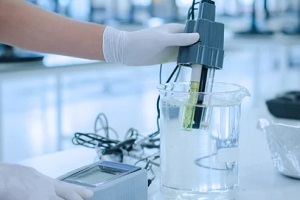 The pH of the water that is produced by a reverse osmosis system is within the range established by the United States Environmental Protection Agency for safe drinking water. Although this is generally considered an aesthetic quality and is therefore not subject to regulation, the agency does recommend aiming for a range of 6.5 to 8.5.
The pH of the water that is produced by a reverse osmosis system is within the range established by the United States Environmental Protection Agency for safe drinking water. Although this is generally considered an aesthetic quality and is therefore not subject to regulation, the agency does recommend aiming for a range of 6.5 to 8.5.
For individuals who do need water with a higher pH for health reasons, some reverse osmosis systems can be equipped with optional filters that can fortify the water with electrolytes and minerals to raise its pH.
Those with severe acid reflux or gastrointestinal ulcers, for example, may want to try this approach. Keep in mind, however, that water of any pH level will not change the pH level of your blood when consumed in normal amounts.
Myth #5: A Water Softener Can Do The Same Job For Less Money
In some areas, a water softener can extend the lifespan of plumbing and appliances, but it will not serve to make water any healthier to drink. In fact, water softeners are used by some households in conjunction with a reverse osmosis system to soften the water before it goes through the reverse osmosis system. This is because hard water may lead to a buildup of scale in a reverse osmosis system and reduce its lifespan.
Unlike a water softener, a reverse osmosis filter can make water safer to consume by removing contaminants such as arsenic and lead that can lead to health issues over time; water softeners only remove the minerals that are responsible for hardness. This means that a water softener simply cannot be used as a replacement for reverse osmosis because it does not serve the same function.
Myth #6: Reverse Osmosis Systems Do Not Remove All The Bad Components Of Water
Reverse osmosis systems are effective at removing dissolved solids such as fluoride and arsenic from water. In addition, their sediment and carbon filtration can reduce a broad spectrum of contaminants. Most reverse osmosis systems can even remove herbicides and pesticides, which are a growing concern throughout the nation.
It is true that a reverse osmosis system cannot remove viruses and bacteria from water. However, this is not a concern for those whose water is sourced from a city treatment plant, as their water is generally considered microbiologically safe.
Although reverse osmosis can remove some bacteria from water, bacteria can also technically grow on the membrane itself and then make its way into the water supply. UV disinfection is an appropriate remedy for water where viruses and living organisms are a concern.
Myth #7: Reverse Osmosis Water Is Just As Good As Water From The Tap
Although the water in most cities must adhere to strict standards, that does not mean that the water that comes out of the tap is ideal for consumption. The ideal safe level of all of the contaminants that can be found in water is not necessarily the same as the level that mass treatment can realistically achieve.
For example, lead is extremely dangerous in any concentration, but city water treatment plants would need to spend an unrealistic amount of money to eliminate it entirely. Therefore, the EPA sets standards that attempt to strike a balance between financial feasibility and long-term health.
Therefore, given that lead cannot be fully eliminated in water treatment, they have set the standard for drinking water at 15 parts per billion. This is still an undesirable amount in practice, and reverse osmosis can reduce the amount of lead in tap water further.
There have also been some recent high-profile cases that thrust water quality issues in different cities in the U.S. into the spotlight. Aging infrastructure, rapid urban growth and insufficient regulation have caused toxic chemicals and other pollutants to make their way into the water supply and put people’s health at risk.
Many people are familiar with the ongoing drinking water crisis in Flint, Michigan, where dangerous levels of lead and other contaminants got into the water supply and left area residents with ongoing health issues, and this has happened in several other cities as well.
Myth #8: Reverse Osmosis Water Is Good, But Bottled Water Is Better
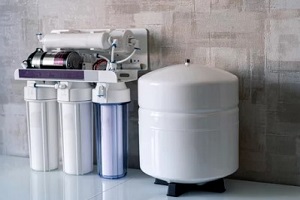 Although some people maintain that bottled water is better than reverse osmosis water, the reality is different. In fact, many bottled water brands rely on reverse osmosis to filter their water. As a result, bottled water is often reverse osmosis water that various companies have bottled and marketed. This means that a home reverse osmosis system can produce water that tastes just as good, if not better, than bottled water.
Although some people maintain that bottled water is better than reverse osmosis water, the reality is different. In fact, many bottled water brands rely on reverse osmosis to filter their water. As a result, bottled water is often reverse osmosis water that various companies have bottled and marketed. This means that a home reverse osmosis system can produce water that tastes just as good, if not better, than bottled water.
However, reverse osmosis water comes with the added benefit of being far greener. According to Harvard University, there are numerous reasons to avoid bottled water, as its entire life cycle uses fossil fuels, causes pollution and contributes to global warming.
They report that more than 17 million barrels of oil are needed in order to produce the number of plastic water bottles needed to meet U.S. demand for bottled water. Moreover, 86 percent of plastic water bottles that are used in America end up becoming litter or garbage.
Myth #9: Reverse Osmosis Water Is Banned In Europe
There have been some claims that reverse osmosis water is banned in Europe, but it is actually one of the most popular methods of purifying water there. It is unclear how this rumor started, although it may be related to the potential for reverse osmosis to waste more water than it produces in certain cases.
However, no country in the European Union has banned reverse osmosis. Reverse osmosis systems and bottled water that has been filtered by reverse osmosis are both widely sold throughout the continent.
The Truth About Reverse Osmosis For Drinking Water
There is a lot of misinformation circulating about reverse osmosis, and some businesses have a vested interest in promoting them, such as bottled water manufacturers and brands that sell other types of filters. However, the truth is that reverse osmosis is a highly effective method of filtering drinking water and has many benefits.
It Removes Contaminants
Reverse osmosis can filter out as much as 99 percent of the harmful substances found in water, including nitrates, pesticides, arsenic, chlorine, lead and fluoride. Some of these substances have been linked to major health problems like kidney damage and cancer. Water that has been filtered via reverse osmosis can reduce your exposure to these risks.
It Can Improve The Taste Of Food
Because reverse osmosis water has a neutral flavor, it can make better-tasting coffee, tea and soups than tap water that has a distinctive flavor. Reverse osmosis water does not contain the types of impurities that may alter the taste of the foods you cook the way other types of water can.
It Reduces Waste
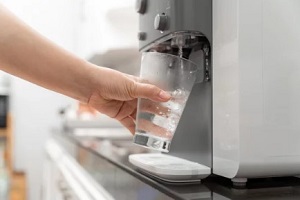 One area in which reverse osmosis has a clear advantage is environmental friendliness. Bottled water doesn’t just generate droves of plastic waste; it can also end up in landfills and oceans, where it makes its way into the environment and threatens wildlife. Humans can avoid this highly problematic source of pollution by using a reverse osmosis system for unlimited access to safe, clean water.
One area in which reverse osmosis has a clear advantage is environmental friendliness. Bottled water doesn’t just generate droves of plastic waste; it can also end up in landfills and oceans, where it makes its way into the environment and threatens wildlife. Humans can avoid this highly problematic source of pollution by using a reverse osmosis system for unlimited access to safe, clean water.
It May Be Necessary For Pets Or Hobbies
For individuals with home aquariums who are raising fish or coral, reverse osmosis systems can ensure they have the purest water possible that is free from added minerals and human contaminants.
Speak With The Water Filtration Experts At Hawaiian Cool Water
Reverse osmosis filtration can provide your home or business with a dependable supply of safe, clean drinking water. Whether you want to learn more about the real science behind reverse osmosis or find out more about our commercial and residential systems, our team is happy to answer your questions. Contact us online today or call us at (808) 755-2421.


